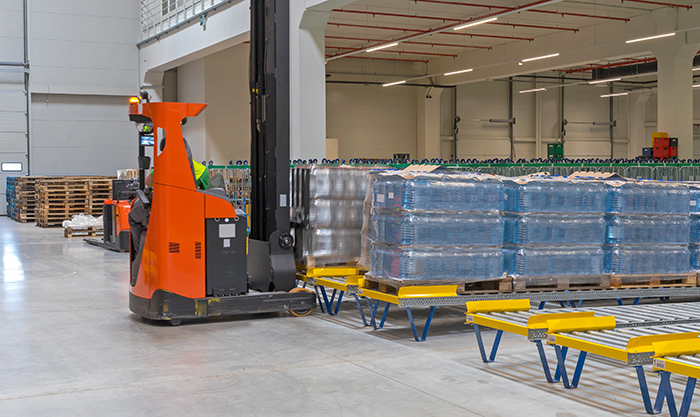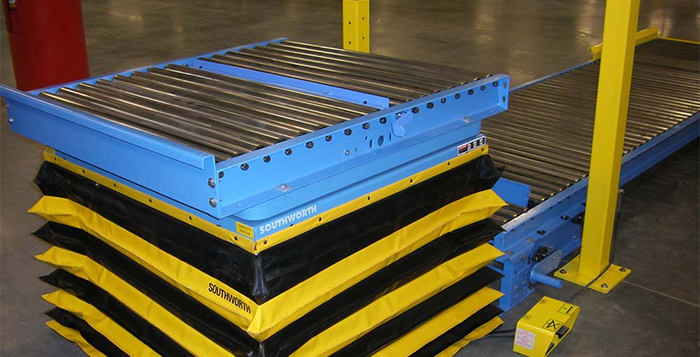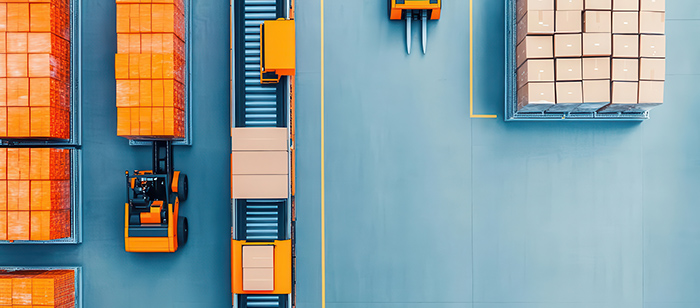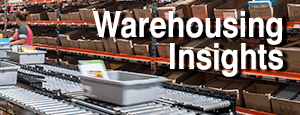Best Practices for Loading & Unloading Pallet Conveyors with Forklifts
Make your pallet transfer zones safer and more efficient

Loading and unloading pallet conveyors with forklifts is an everyday, all-day task.
Done right, it’s fast and efficient. Done wrong, product damage, collisions, injuries, and workflow bottlenecks happen. I’ve seen it in dozens of warehouses, even in highly automated operations, and most of them tend to bridge the shipping dock and the end conveyor lines with forklifts (these days, AGVs and AMRs often do this work). Pallets are large, heavy and in motion when they’re transported on conveyors. That combination of size, pressure and movement can result in damage or injuries when not properly controlled.
Let’s break down how to optimize your conveyor loading and unloading zones for safety, speed, damage prevention, and ease of access. We’ll also touch on traffic control strategies that keep people out of harm’s way and don’t impede the flow of traffic in and around your staging and dock areas.
Forklift + conveyor = risk zone for pedestrians in the area
Transfer zones where forklifts interact with pallet conveyors are some of the most confusing warehouse areas. Tight spaces, poor visibility, crisscrossing traffic and pedestrian proximity all contribute to the problems. Drivers are often adjacent to staging areas and docks, where pallets can be stacked, stored or staged. These areas are often full of people on foot, other forklifts, carts, and sometimes automated vehicles. Protecting people from these hazards is critical.
To reduce collision hazards:
- Establish pedestrian exclusion zones around conveyor infeed/outfeed points using floor tape, bollards, fencing, or gates. This isn’t always practical, depending on how the forklift interacts with the conveyor and other operational factors.
- Automated gate systems that restrict foot traffic when forklifts are present can be installed in some applications. (Example of a gate system that restricts pedestrians from the transfer zone while a forklift or automated vehicle interfaces with a palletizer)
- Consider automated motion sensors that can be installed overhead, or proximity alarms installed on forklifts and people so that sight lines and visibility are improved.
- Train forklift drivers specifically on how to approach, align with, and load/unload conveyors.
- Schedule times so that people are not present during trailer loading or unloading
Ideally, forklift transfer zones should be treated as “no-go” areas for foot traffic when a forklift is operating nearby.
Managing pedestrians at forklift access points
Forklift zones and people don’t mix and shouldn’t be working routinely in the same areas. However, I know the reality: people and lift trucks are frequently required to occupy the same space, so you have to make it work. The challenge is keeping them physically—and behaviorally—separated. Strong traffic control strategies include:
- Dedicated forklift lanes and pedestrian walkways clearly marked and enforced.
- Warning systems such as flashing lights, horns, or motion sensors that alert people when forklifts are active. Forklift warning lights are highly recommended.
- Smart gate systems that restrict access to active conveyor zones unless it’s safe.
- Clear signage and floor markings that communicate risks and clearly mark who is supposed to be where.

Above: forklift interfacing with the end of a pallet conveyor line. Note the large amounts of stacked pallets around this access point. These pallets limit the driver’s vision and impede his ability to maneuver. This affects pedestrian safety because neither driver or warehouse worker can easily see the other party. Also, since the driver must back up into limited space, the chances of damaging the conveyor are enhanced. Ideally, these areas should be clear of people and other obstructions, but that’s often impractical.
Restriction-based safety processes and throughput balance
Everyone wants throughput—but that shouldn’t come at the expense of safety. Ways to increase speed without increasing risk:
- Streamline travel paths to minimize forklift turning and backing near conveyors. This protects nearby workers on the ground, but also reduces the chances of a forklift colliding with expensive conveyors during the process if it needs to back up between lines.
- Use angled conveyor entry points so forklifts can enter and exit without complex maneuvers. A key consideration is that the forklift’s path should be as simple, straight and short as possible.
- Integrate sensors and automation—for example, start the conveyor automatically when a pallet is detected.
- Stagger loading schedules to reduce congestion at key transfer zones.
The goal: eliminate delays and confusion while giving drivers a predictable, repeatable routine.
Read more: Choosing the Right Pallet Conveyor
Design the end of the line with forklift access at top mind

In this image, a rotating conveyor-top scissor lift serves as a transfer between the conveyor and forklifts. It separates the forklift from direct contact with the conveyor while providing directional versatility and load points.
If a forklift operators struggle to get a pallet on the conveyor, the system is broken. Protecting conveyor structures from forklift impact is a critical and sometimes overlooked design consideration. Forklifts aren’t exactly precision instruments, and even skilled operators can bump equipment. What can you do to create a driver-friendly and safer transfer zone?
Providing ample turning radius and approach clearance
A smoother experience for operators means faster cycle times, fewer accidents and less damage to palletized loads, facility structure, conveyors or forklifts.
Avoid placing conveyors too close to walls, columns, or obstructions. Force the ends of conveyor lines to the center of the building and situate the line so that columns aren’t near transfer points. These structural impediments are usually avoidable in the design phase with good measurements, layouts and forethought. Maintain clean, dry floors with good traction and clear lines of sight. Whenever possible, don’t surround the conveyor line with stacks of pallets or full pallets awaiting shipment or processing.
Keep the loading zone well-lit, especially if it’s used during night or shift work. If that can’t be done, consider installing reflectors on the conveyor and lights on the forklift.
Control pallet speed and position as it reaches the end of the conveyor line
Fully loaded pallets weighing thousands of pounds moving towards the end of a conveyor line should be controlled by a combination of system design and components. Pallet conveyors should have braking and slowing zones at the end of the line to ensure gentle positioning. Pallet conveyors should align pallets where fork pockets are easily accessible once they come to a stop. If you are concerned with people in the zone, consider measures such as sensors that can warn them away from loading/unloading stations.
Install heavy pallet stops or impact guards for protection and control
Controlling pallets on the conveyor is often about the end of the line, and welded steel pallet stops at conveyor infeed/outfeed points is one of the most economical and safest ways.
These should be sturdy enough to withstand direct contact with a loaded pallet moving at the conveyor’s designated speed. Stops function two ways: first, they make sure the pallets are positioned uniformly for easier and more consistent access to forklifts and AGVs. They also absorb impacts, rather than letting the forklift bump the conveyor itself. If there is substantial damage, you’d rather replace a pallet stop or guard than the conveyor structure, rollers, motors or other expensive mechanical components.
Usually–but not always–forklifts are accessing pallets from the end of the conveyor line. Forklifts sometimes need to access palletized loads from the side of the conveyor, which reduces the utility of pallet stops. In these cases, bollards or wheel stops in the right positions can help protect the conveyor line.
Guard rails and bollards
Installing bollards, guardrails or u-shaped rails in front of a conveyor where forklifts access it is effective and inexpensive. This rail can be positioned below the conveyor’s roller height, and far enough in front of it to both allow forklifts to access pallets and prevent them from directly striking the conveyor structure.

Design your transfer zones for safety and efficiency
For new conveyor projects—or major retrofits—design matters.
Plan ahead with:
- Conveyor elevations that match forklift specs.
- Pallet turntables or transfer cars to reduce the need for tight maneuvers.
- Integrated automated pallet handling systems to reduce or eliminate forklift interaction altogether.
Loading and unloading pallet conveyors with forklifts is one of the most critical transfer points in your warehouse. By focusing on safety, speed, damage prevention, and traffic control, you can turn a risky zone into a high-efficiency workflow area. Measures like guarding, gates, floor tape, sensors, or better training will make the process safer and faster.
Read more
- Integrating Conveyors and Industrial Lifts
- Cisco-Eagle’s Guide to Pallet Handling (PDF)
- How Dock Operations Improve Customer Service
Tags: forklifts, conveyor safety
Scott Stone is Cisco-Eagle's Vice President of Marketing with 35 years of experience in material handling, warehousing and industrial operations. His work is published in multiple industry journals an websites on a variety of warehousing topics. He writes about automation, warehousing, safety, manufacturing and other areas of concern for industrial operations and those who operate them.



